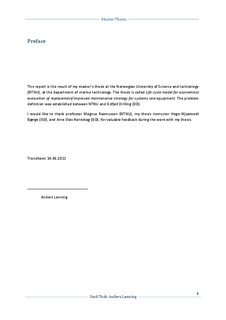| dc.description.abstract | Systems that deteriorate over time can result in increased operational costs. Reduced efficiency, increased fuel consumption, increased failure rate that induces increased downtime costs, are some of the consequences due to deterioration.
Analysis of systems and equipment that deteriorate over time is an important aspect of ageing management. In this thesis, the available literature from maintenance and life cycle theory has been mapped. The goal was to develop a model for Odfjell Drilling, which could be used to estimate the life cycle costs for optimal repair intervals for systems and equipment.
Two models were derived. The first model was based on reliability theory, using Barlow & Hunter´s fixed age interval. Several parameters have been identified as necessary input values. The idea was to collect the input parameters from the operational database that Odfjell Drilling posses, and use these for optimizing optimal repair intervals, by means of the common Reliability Centered Maintenance (RCM) methodology. When the optimal intervals are found, the reduction of costs can be calculated for the remaining system life.
A major problem with the reliability model is that a probability density function (PDF) must be obtained. Obtaining this, in practice, is very difficult; systems are subject to maintenance, which prevents their history to become available to the analyst. Use of subjective expert opinions for how they think the system will behave, is one approach to obtain the PDF. However this is considered as inefficient, time-consuming and inaccurate. The model approach was hence rejected.
The second model is an availability-based model, which purpose is to identify systems that are main contributors to downtime. When these are found, diagnosis can be developed and evaluated in order to increase the system availability. Thus reducing the costs of downtime, which goes directly on the bottom-line of the budget.
Due to significant lack of data, the availability-based model could never be tested properly. The main idea was to test it on a racking arm on a platform that is in Odfjell Drillings portfolio. The few results that were obtained will be in a separate report as the data is sensitive.
Use of condition-based maintenance (CBM) is considered to be a strategy that offers more flexibility to the user, in terms of planning multiple actions. It is recognized that many systems, such as pumps and piping, could be subject to condition monitoring (CM) to a greater extent than they are today.
CBM will require the development of a database for storage of system history. Trend analysis can be evaluated and used as a tool for decision making in maintenance planning. As for Odfjell Drilling, it is recommended that they investigate the potential that CBM offers, and put a single model for optimizing equipment and systems at rest. | nb_NO |
